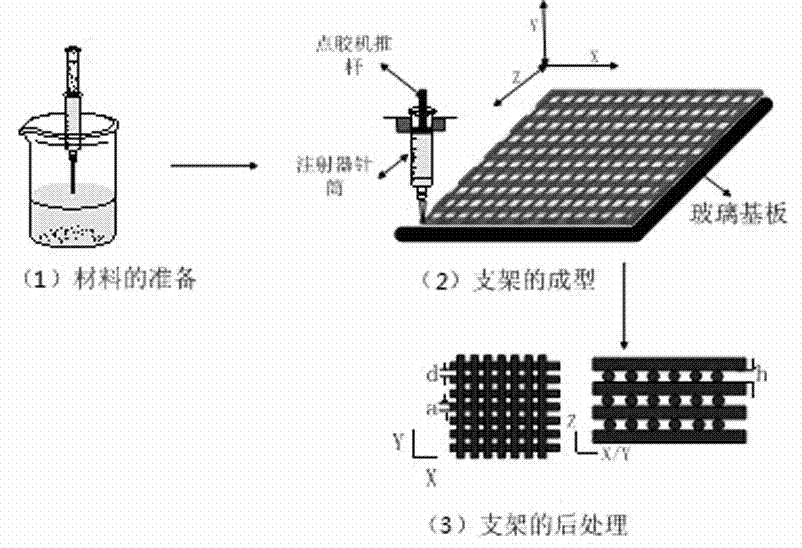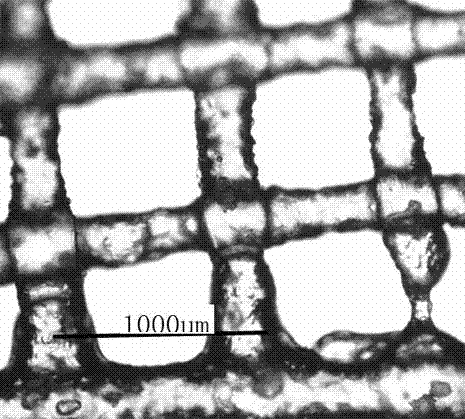Method for preparing polyving akohol/nanosized silica composite hydrogel scaffold through 3D printing
A technology of nano-silica and composite hydrogel, applied in medical science, prosthesis, etc., can solve the problems of low strength, insufficient fineness of the scaffold, and the inability to realize the controllable and adjustable scaffold structure and holes, and achieve internal Effect of controllable porosity and good softness
- Summary
- Abstract
- Description
- Claims
- Application Information
AI Technical Summary
Problems solved by technology
Method used
Image
Examples
Embodiment 1
[0032] Step 1: Preparation of materials, including the following sub-steps:
[0033] Sub-step 1.1: Add 8g of PVA resin to 92g of deionized water, stir and disperse evenly, and then place it in a constant temperature water bath at 95°C to condense and reflux for 2 hours until the PVA is completely dissolved to obtain 100g of PVA solution;
[0034] Sub-step 1.2: Place 100g of the PVA solution prepared in sub-step 1.1 in a vacuum oven at 95°C for degassing for 30 minutes. The fumed nano-silicon oxide (SiO 2 ) in a beaker, fully stirred until the gas-phase nano-silica is uniformly dispersed in the PVA solution to obtain a mixed sol with thixotropic properties;
[0035] Step 2: Forming of the Bracket:
[0036] The model used is The Loctite ?200D Benchtop Robot's robotic dispensing machine drives a medical syringe connected to a pipette dripper with a diameter of 0.1mm to extrude the mixed sol prepared in step 1, adjust the XY axis platform movement speed to 100mm / min, and the Z ...
Embodiment 2
[0042] Step 1: Preparation of materials, including the following sub-steps:
[0043] Sub-step 1.1: Add 10g of PVA resin to 90g of deionized water, stir and disperse evenly, and then place it in a constant temperature water bath at 90°C for 3 hours to condense and reflux until the PVA is completely dissolved to obtain a PVA solution;
[0044] Sub-step 1.2: Place the PVA solution prepared in sub-step 1.1 in a 95°C vacuum oven for degassing for 30 minutes. Fumed silicon oxide (SiO 2 ) in a beaker, fully stirred until the nano-silica is uniformly dispersed in the PVA solution to obtain a mixed sol with thixotropic properties;
[0045] Step 2: Forming of the Bracket:
[0046] Use the robot dispensing machine model Sistema Dosificador Ultra 2800 to drive a medical syringe connected to a pipette dropper with a diameter of 0.5mm to extrude the mixed sol prepared in step 1, and adjust the moving speed of the XY axis platform to 220mm / min, Z Shaft stepping height 0.5mm, extruder extr...
Embodiment 3
[0053] Step 1: Preparation of materials, including the following sub-steps:
[0054] Sub-step 1.1: Add 12g of PVA resin into 88g of deionized water, stir and disperse evenly, and then condense and reflux in a constant temperature water bath at 95°C for 2 hours until the PVA is completely dissolved to obtain 100g of PVA solution;
[0055] Sub-step 1.2: Place 100g of the PVA solution prepared in sub-step 1.1 in a vacuum oven at 90°C for degassing for 60 minutes. After degassing, slowly add the degassed PVA solution into the gas phase containing 12g Silicon oxide (SiO 2 ) in a beaker, fully stirred until the nano-silica is uniformly dispersed in the PVA solution to obtain a mixed sol with thixotropic properties;
[0056] Step 2: Forming of the Bracket:
[0057] The model used is The Loctite ? The robot dispensing machine of 400D Benchtop Robot drives the medical syringe with a fine needle tube with a diameter of 0.3mm to extrude the mixed sol prepared in step 1, adjust the mo...
PUM
| Property | Measurement | Unit |
|---|---|---|
| Particle size | aaaaa | aaaaa |
| Apparent viscosity | aaaaa | aaaaa |
| Diameter | aaaaa | aaaaa |
Abstract
Description
Claims
Application Information
 Login to View More
Login to View More - R&D
- Intellectual Property
- Life Sciences
- Materials
- Tech Scout
- Unparalleled Data Quality
- Higher Quality Content
- 60% Fewer Hallucinations
Browse by: Latest US Patents, China's latest patents, Technical Efficacy Thesaurus, Application Domain, Technology Topic, Popular Technical Reports.
© 2025 PatSnap. All rights reserved.Legal|Privacy policy|Modern Slavery Act Transparency Statement|Sitemap|About US| Contact US: help@patsnap.com



